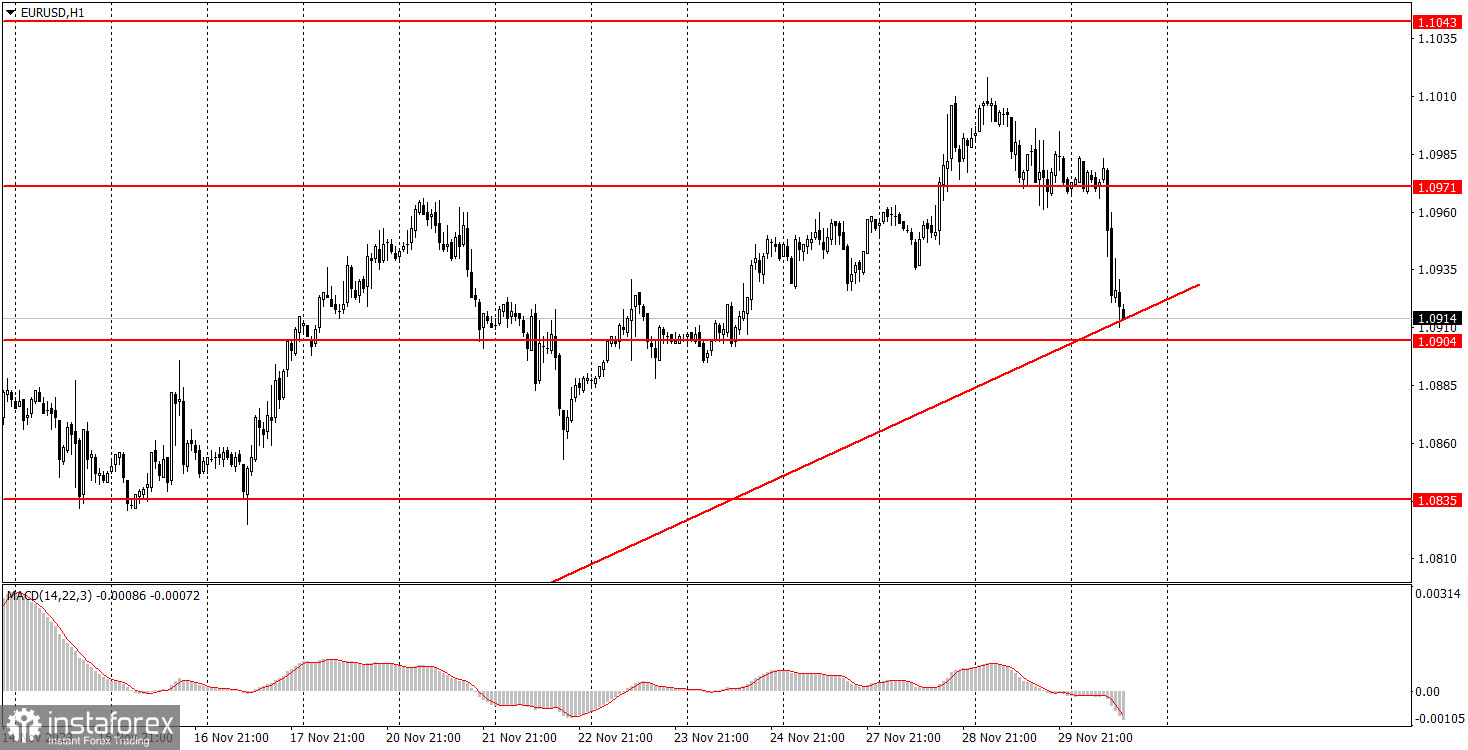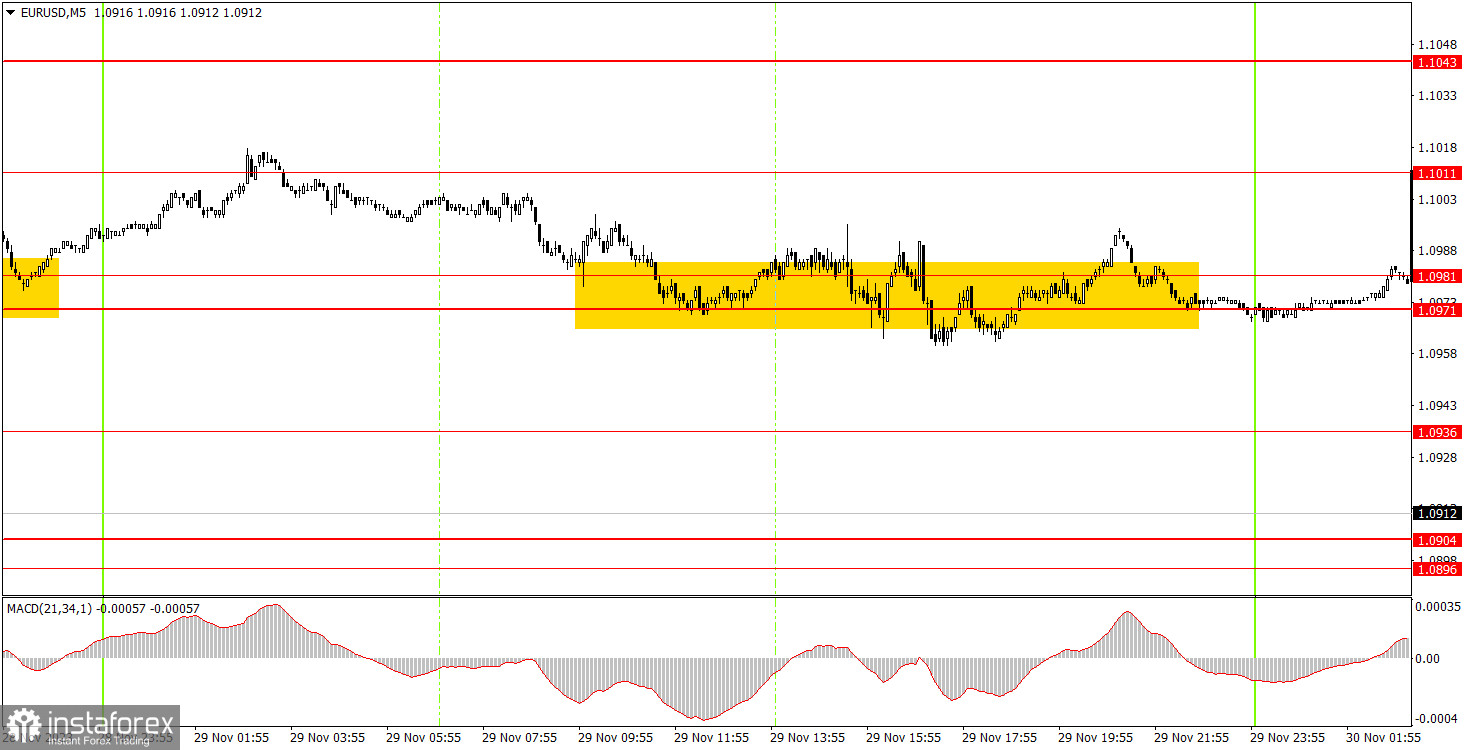Analyzing Wednesday's trades:
EUR/USD on 30M chart

EUR/USD started a minor bearish correction on Wednesday but couldn't go below the level of 1.0971. In contrast to Monday and Tuesday, there was a macroeconomic backdrop that could have pushed traders to be more active. In particular, the German inflation report was released, which fell more than expected, and the U.S. GDP report showed stronger growth than anticipated. Therefore, based on all the indicators, the USD was expected to show decent growth on Wednesday, but once again, this did not happen.
We have repeatedly mentioned that the current uptrend is illogical. There is no reason for the market to continue buying the pair. Everything was logical when the U.S. reports were weak, and the dollar fell. But now the greenback is getting weaker even if there are no reasons for it to fall. Therefore, we continue to expect a strong downward movement in the future and the pair to cross the trend line. In fact, this significant decline may have already started, as today the pair plummeted.
EUR/USD on 5M chart

There was nothing to analyze on yesterday's 5-minute chart. As seen above, the price practically stood still around the range of 1.0971-1.0981 throughout the day. Beginners might not have immediately recognized the flat market and opened one or two trades. It was impossible to set a stop-loss to breakeven because the price did not move in the intended direction by even 15 pips. Therefore, we can say that traders were quite passive on Wednesday.
Trading tips on Thursday:
On the 30-minute chart, the corrective phase remains intact, but today it has started to fall, which could be the start of a new trend. The pair could overcome the trend line as early as today. If this happens, we will expect a decline of 500-600 pips minimum over the next 1-3 months. The key levels on the 5M chart are 1.0568, 1.0611-1.0618, 1.0668, 1.0733, 1.0767-1.0781, 1.0835, 1.0896-1.0904, 1.0936, 1.0971-1.0981, 1.1011, 1.1043, 1.1091. A stop loss can be set at a breakeven point as soon as the price moves 15 pips in the right direction. In Germany, a report on retail sales was released on Thursday, which the market ignored. As expected, the eurozone inflation data exerted pressure on the single currency. The U.S. will release several secondary reports that are unlikely to move the market.
Basic trading rules:
1) Signal strength is determined by the time taken for its formation (either a bounce or level breach). A shorter formation time indicates a stronger signal.
2) If two or more trades around a certain level are initiated based on false signals, subsequent signals from that level should be disregarded.
3) In a flat market, any currency pair can produce multiple false signals or none at all. In any case, the flat trend is not the best condition for trading.
4) Trading activities are confined between the onset of the European session and mid-way through the U.S. session, post which all open trades should be manually closed.
5) On the 30-minute timeframe, trades based on MACD signals are only advisable amidst substantial volatility and an established trend, confirmed either by a trend line or trend channel.
6) If two levels lie closely together (ranging from 5 to 15 pips apart), they should be considered as a support or resistance zone.
How to read charts:
Support and Resistance price levels can serve as targets when buying or selling. You can place Take Profit levels near them.
Red lines represent channels or trend lines, depicting the current market trend and indicating the preferable trading direction.
The MACD(14,22,3) indicator, encompassing both the histogram and signal line, acts as an auxiliary tool and can also be used as a signal source.
Significant speeches and reports (always noted in the news calendar) can profoundly influence the price dynamics. Hence, trading during their release calls for heightened caution. It may be reasonable to exit the market to prevent abrupt price reversals against the prevailing trend.
Beginning traders should always remember that not every trade will yield profit. Establishing a clear strategy coupled with sound money management is the cornerstone of sustained trading success.
 English
English 
 Русский
Русский Bahasa Indonesia
Bahasa Indonesia Bahasa Malay
Bahasa Malay ไทย
ไทย Español
Español Deutsch
Deutsch Български
Български Français
Français Tiếng Việt
Tiếng Việt 中文
中文 বাংলা
বাংলা हिन्दी
हिन्दी Čeština
Čeština Українська
Українська Română
Română

